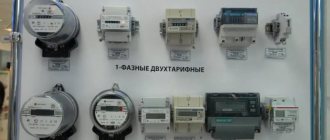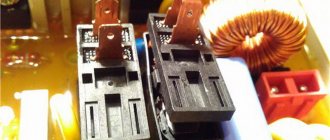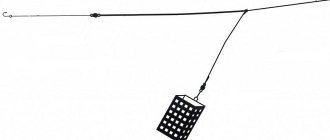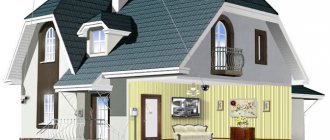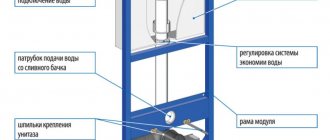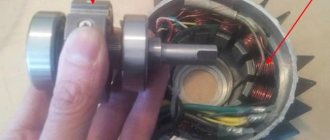A DIN rail is a special mounting strip placed in distribution cabinets and similar prefabricated structures. Its main purpose is to serve as a basis for mounting RCDs, circuit breakers and other protective devices serving the power supply line. A standard size DIN rail can accommodate several samples of devices of various classes, including powerful magnetic starters. It all depends on the specific width of the modular machine, determined by its functional purpose.
Types of DIN rails
Depending on the shape of the fastening strip, known samples of products of this class are divided into the following types:
- TN type rails (their varieties are TN 15, TN 35, TN 75);
- class “C” products (C20, 30, 40, 50);
- G-type strips (G 32).
The first of these designs is shaped like the letter of the Greek alphabet “omega” and is the most common among industrially produced samples. The housings of electricity meters and automatic machines are traditionally mounted on it.
In C-shaped models, the side edges are curved inward, so its profile allows you to fix terminal blocks of a special shape and design. The G-bar is a slightly modified modification, used extremely rarely and used for the same purposes. The length of these fasteners, depending on the manufacturer, varies from 7.5 cm to 2 meters, which allows you to place on them from 4 to 96 pieces of protective devices with the standard width of one machine module.
According to their design, DIN rails can be perforated - with holes filled along the entire length - and solid or cast.
The advantage of the first designs is ease of installation, since if there are holes drilled in increments of 10-15 mm, it is much easier to attach a steel rail. But cast samples are more durable and reliable. They are not deformed if there are a large number of circuit breakers in the distribution panel.
Types of slats
Being a universal device, din rails have significantly simplified electrical installation work. However, in practice, varieties can be used that differ in many respects, primarily in shape. There are these types of din rails:
Ω-shaped. This is the modification most often used by electricians, in which the edges, when viewed in profile, are curved outward. It is used when installing distribution boards, automation, and meters. The design is quite simple, and in accordance with GOST there is a TN marking.
Moreover, the following options are assumed - TN 15, TN 35, TN 75. For household electrical circuits, type TN 35 is used - height 7.5 mm and width 35 mm. Used for installation in floor and suspended panels.
Type "C". The edges of the electrical installation device are curved inwards. Therefore, it is convenient to attach hardware clamps and terminal blocks to such a strip. It is marked C20, C30, C40, C50.
Type "G" has internally concave edges, but the height of the ends will vary. Rarely found on sale, the bar is aimed at imported equipment, which is distinguished by the same type of fasteners.
Features of application
DIN rail is a foreign invention that takes its name from the German standard designated DIN 43880-1988. In our country, their use is regulated by GOST R IEC 60715-2003. These products are sometimes called mounting rail. The full name looks like this: “mounting rail for fixing protective devices in low-voltage distribution and control equipment for electrical networks.”
In accordance with this definition, its scope extends to the following cases:
- the need to install electric meters and other types of measuring equipment in the distribution cabinet;
- the need to place protective equipment there (RCDs, automatic circuit breakers, voltage relays, etc.);
- If desired, install special connecting fittings into the cabinet.
The decisive factor determining the capacity of such a rail is the width of the machine module or similar protective equipment installed on its base.
When assessing the width of the machines, they are based on the specific number of protective devices used in the panel, which can have a single-pole or multi-pole design. The second option concerns three-phase networks. In general, its use is limited to this particular set of functions, but in certain situations other directions for using the DIN rail are possible.
Dimensions and installation method
In domestic conditions, standard strips with a profile width of 35 mm (TN 35), having a shelf height of about 7.5 mm, are traditionally used. Different versions of the product may differ in the declared thickness of the profile (1-1.5 mm) and the diameter of the holes filled during perforation (4 or 5 mm). To attach them to the distribution board guides, you will need bolts of the appropriate size.
Modules
In cases where the entire structure has been successfully installed and none of the required minimum is needed, it can be improved with additional modules. They are optional, but will be very useful for those who want to spend a little of their time. So, these can be distinguished:
Limiter. It is necessary in cases where the movement of the machines is not needed and will become more of a problem than a useful function. Installation is possible as long as there is free space. Rosette group. Only professional builders or those who see the point in this will need it. This is far from a necessary improvement, but quite useful if you know why to use it. Voltammeter. Allows you to monitor power consumption in real time. Useful in cases where you need to keep records. Distribution blocks. Needed for power distribution
The three-phase shield is of particular importance. Counter. Thanks to it, you can track the total shield consumption. The only problem may be the size, since even compact ones are often large.
The only problem may be the size, since even compact ones are often large.
However, you should always remember that the distinguishing feature of modules is their versatility. Therefore, if there is a possibility that the installed innovation cannot be promptly dismantled in the future, it is recommended to refrain from using it.
Knowledge about slats is not difficult to access and non-specific - it is available to everyone. However, such simple information about the types and methods of fastening will save time and money on repairing or building your own home.
Calculation of module width
The dimensions or dimensions of circuit breakers mounted on a DIN rail are usually calculated taking into account the following considerations:
- what is the total number of these devices planned to be installed in accordance with the wiring diagram used;
- what type of metering device (meter) and circuit breakers are supposed to be installed on it;
- what is the minimum gap between these devices that should be left.
If two automatic machines or RCDs can be mounted almost close to each other, the devices must be installed next to the electric meter at some distance (at least 1-2 centimeters).
When calculating the number of devices that can fit on a DIN rail, it is necessary to take into account their functional purpose. A two-pole circuit breaker has a larger width than a single-pole circuit breaker.
Manufacturing materials and load characteristics
The material from which a particular DIN rail is made must be suitable for its purpose. This means that it is necessary to take into account the expected loads, depending on which steel or aluminum products are selected. The first of these samples are more durable in their structure and can withstand extreme loads with a minimum strip thickness of only 1 mm.
By critical or extreme loads we mean the situation when large devices such as frequency converters, powerful magnetic starters or three-phase power circuit breakers are mounted on the rail.
Aluminum slats are capable of “holding” maximum stresses of mechanical deformation only with a thickness of 1.5 mm. Accordingly, the range of power and protective equipment placed on them will be significantly limited.
Load characteristics
Because a typical DIN rail is manufactured as a profile product, it can withstand greater deformation loads than a metal plate of the same size. Typical load characteristics of DIN rails are standardized by current standards for a number of characteristics, including the type of metal. Aluminum strips are available in the following versions:
- 1 mm thick slats designed for installation of single modular devices: circuit breakers, RCD units, power modules;
- 1.1 mm strips, designed for installation of single devices placed in several rows;
- the same products, but with an indicator of 1.4 mm, designed for modular equipment of any class and weight.
All these products are cut into pieces of the required length before installation.
The kit may include steel slats with a thickness of 1.0 mm, the load capacity of which is similar to an aluminum rail with a thickness of 1.5 mm. They can withstand maximum loads without restrictions on weight and number of seats within the permissible size. In addition, manufacturers of switchboard equipment often equip distribution cabinets with non-standard profile rails.
Features of choice
When selecting the necessary device, the following nuances are taken into account:
- What is a pulse relay: principle of operation, types, description of devices and connection diagrams. 155 photos of pulse-type relays and video installation instructions
- Photo relay for street lighting - selection criteria, tips for connecting and placing the device (135 photos)
- Pulse protection device: classification, limiter connection diagram and tips for choosing a device (155 photos)
- Particularly popular are 1 mm steel slats with a length of 1 m. This is a universal option that is cheaper than its aluminum counterpart.
- The plates are cut to the size of the shields. The choice is made according to the dimensional characteristics of the box where installation will be carried out. For new fastenings, the size of the strip should include a margin.
- When installing modules for DIN rails, a 10-15 mm plate plus a margin is usually taken.
- If you buy assembled panels, then they already have slats of the required size installed.
The rail is fastened along the edges. Sagging should be avoided; dimensions must clearly correspond to the installation location. If necessary, it is advisable to use special holders.
How to choose slats for installation in a closet
Since the width of the 1 DIN machine is the determining factor when choosing the right size of DIN rails, you need to familiarize yourself with the range of metal products. The most common samples are represented by steel slats with standard sizes: thickness 1 mm and length up to a meter. They are distinguished by their versatility, and are significantly cheaper in price than their aluminum counterparts.
Immediately before use, they are cut into blanks of the required size to fit the housing dimensions of ready-made switchboards. In this case, each specific rail is adjusted in length to the required standard size. When assembling a new shield, its dimensions are selected based on the finished slats plus a small margin.
The size of the DIN rail machine is critical when designing distribution equipment of various classes. Only taking into account this indicator can one correctly calculate its operational parameters and the permissible load on the load-bearing elements of the structure.
DIN rail
- a generalized name for a metal profile used in electrical engineering. Depending on the requirements (weight, strength, current strength through the grounding terminals), either galvanized steel or aluminum is produced. It can be continuous or with a regular perforation step; there are also options with preliminary notching to facilitate cutting to a certain length.
Available in several varieties, named after the similarity of the profile type with the letter of the English alphabet [⇨].
Used for fastening various modular equipment (circuit breakers, RCDs, etc.) in electrical panels, cabinets or installation boxes. The use of rails, coupled with the minimization of elements used in electrical products, has led to the emergence of a fundamentally new approach in the manufacture of equipment - very complex devices and devices, sometimes with built-in microcontrollers, are placed in compact standard-sized cases.
Mounting circuit breakers on the mounting rail
A DIN rail, also known as a mounting rail, is installed in the electrical panel with two bolts. It is possible to mount it on the wall.
In modern circuit breakers, the machine design provides a latch for the DIN rail on the back side.
- The latch moves down.
- The machine is placed on the rail, clinging to the upper protrusions.
- The latch closes (Click on the photo).
- The circuit breaker is removed in the reverse order. Everything is simple and not even interesting, just when attaching the machine, follow safety precautions and turn off the power to the group electrical circuit that it protects, or better yet, turn off the input machine.
Let's see how we managed without the German invention. Or is it not German?
Types [edit | edit code ]
Ω-type (omega-type) rack [edit | edit code]
TN35 is a 35 mm wide metal rail with a special profile. The standard for this rail was developed by the German Institute for Standardization and subsequently adopted by the International Electrotechnical Commission and also as a European Standard (EN).
In Russia, the TN35 rail was introduced by the national standard GOST R IEC 60715-2003 “Low-voltage distribution and control equipment. Installation and fastening on rails of electrical devices in low-voltage complete distribution and control devices" [1].
There is also a rail of reduced format, both in thickness and in profile width - such rails are usually used for installing small-sized terminals, not devices.
The material of the slats can be steel, copper, aluminum. The surface can be processed (anodizing, galvanizing, galvanizing and other methods).
It can be either solid or perforated.
C-type rack [ edit | edit code]
In slats of this type, the ends are bent inward. Therefore, the profile of such a rail resembles the Latin letter C. Type C rails are usually used for installing hardware clamps, terminal blocks, etc. The width of the rail is 32 mm, the height is 15 mm.
G-type rack [edit | edit code]
In this type of rails, the ends are bent inward in the same way as in C-type rails, but one end is smaller and lower than the other, so the profile of such a rail resembles the Latin letter G. G-type rails are used for installing hardware clamps, terminal blocks, etc. .The width of the rail is 32 mm; height of long end 15 mm; short 9 mm.
Types of DIN rails
Due to the fact that DIN rails are often used to attach a modular socket, let’s look at their varieties.
Depending on the profile, there are several types of devices:
- Ω-type (Omega) or TH35. This type got its name due to the outwardly curved ends of the rail. In cross-section, the product resembles the letter Omega of the Greek alphabet. Another name was taken because of the unified size; its width is 35 mm. This type is the modern and most used type of device. In our country, it is classified as a rail for installation and fastening of low-voltage control and distribution devices. In addition, there is an auxiliary modification of the Omega type with a reduced profile width and thickness. It is not intended for mounting equipment, but is used to attach clamps in order to connect the wires of mounted devices.
- G-type. In appearance, the product resembles the letter G of the Latin alphabet - this is where it got its name. Its ends are bent into the inner part of the profile, one of which is smaller and lower than the other. It is used when installing and casing blocks for connecting wires, hardware clamps and terminals.
- C-type. Just like the previous type, this variety received its name due to the shape of the profile, the ends of which are bent inward and have the same length, reminiscent of the letter C. The scope of application of this type of slats is similar to the G-type. However, certain devices or additional devices that need to be installed in the panel are mounted exclusively on this form of rail.
In addition to their configuration, DIN rails differ in the material of manufacture:
- Steel with special coating. It is one of the main types of material. An additional coating layer protects the product from the negative effects of the external environment and prevents corrosion destruction.
- Copper.
- Aluminum.
Depending on the manufacturer, the devices may have holes or notches that allow them to be easily secured or divided into pieces of the required length.
Regarding the dimensions of the slats, it should be noted that they are standard:
- 35x7.5 mm is the most common option due to the fact that most electrical appliances are designed for installation using rails with these parameters;
- 35x15 mm - used in some areas of industry for installation and fastening of professional electrical installations;
- 15x5 mm – used for installation of non-standard mounted installations used in narrow industrial areas.
Application features described in the standards [edit | edit code]
- According to DIN 43880, for a mounting rail, the width of one mounting module is 17.5 mm. The center-to-center distance of two adjacent single-thickness modules is set to 18 mm.
- The distance between the rows of slats (vertical) is 125 mm.
- The distance from the front plane of the mounting rail to the front plane of the front surface of the module installed on the rail should not exceed 44 mm, while the distance to the plane of the module’s protective material should not be less than 47 mm.
Gallery [ edit | edit code ]
DIN rail mounted terminals
Examples of fixing equipment on a DIN rail in the electrical panel of a three-phase power supply system, from left to right: terminal blocks (5 white for phase wires, 1 blue for neutral wire, 1 yellow-green for protective grounding wire), three-phase modular package automatic phase current limit switch , three-phase differential current device (RCD) with a leakage current threshold of 30 mA, relay and contactor for phase control and voltage protection]]
When choosing an electrical panel, in addition to the design (internal, overhead) and the material from which it is made (plastic or metal), an important criterion is its dimensions, or rather the number of panel modules.
A module in a panel is considered to be one single-pole circuit breaker - an automatic circuit breaker, with an average width of 18 mm.
In a word, the maximum possible number of installations of single-pole circuit breakers in a switchboard is the number of switchboard modules.
Therefore, when purchasing a shield, it is necessary to at least approximately determine the modular elements of the shield - automatic machines, RCDs, meters, etc. and their quantity.
Here are the approximate numbers of spaces (modules on a DIN rail) for the main modular elements:
| Single-pole circuit breaker – 1 module |
| Single-phase two-pole circuit breaker – 2 modules |
| Three-pole circuit breaker - 3 modules |
| Single-phase RCD (Residual Current Device) – 3 modules |
| Three-phase RCD – 5 modules |
| Three-phase differential circuit breaker – 6 – 8 modules (depending on the manufacturer) |
| Modular electricity meter on DIN rail – 6 – 8 modules (depending on manufacturer and design) |
| Modular socket for panel on DIN rail – 3 modules |
| DIN rail terminal – 1 module |
| Modular bus for PE conductor DIN rail – 5 modules |
It is better to buy a shield with a small reserve in terms of the number of modules - you should not buy it “back to back”. For example, if the total number of modules is 12, then it is better to purchase a shield for 16 modules. This will provide the necessary reserve in case of changing the wiring diagram or adding new “points”.
If the panel is not completely filled with modular elements, in order to prevent foreign objects from entering the electrical panel, you can use special plugs for panels for empty modules. This will add greater aesthetics, improving the appearance of the shield.
